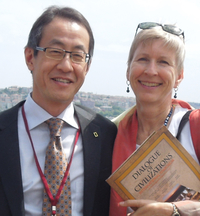
- This event has passed.
Takeshi Inomata and Daniela Triadan – “Early Formal Ceremonial Complexes and Olmec-Maya Interaction”
September 20, 2021 @ 7:00 pm - 8:30 pm MST
ALL AAHS LECTURES ARE OPEN TO THE PUBLIC BUT YOU MUST PREREGISTER. TO REGISTER CLICK HERE.
The origins of Maya civilization and its relation with Olmec civilization have long been debated. To examine this question, we have been conducting archaeological investigations at Ceibal, Guatemala, and in the Middle Usumacinta region in southeastern Mexico. In Mexico, we identified the site of Aguada Fénix, with a rectangular artificial plateau measuring 1,400 m in length and dating to 1,050-750 BC. This is the largest and oldest monumental construction in the Maya area. This find encouraged us to expand our study of similar formal ceremonial complexes by analyzing lidar data. By examining low-resolution lidar obtained by the Mexican government, we covered an area of 85,000 km2, including the Olmec region and the western Maya lowlands. The identifications of many complexes, most of which were not known to archaeologists before our research, transform our understanding of the emergence of Mesoamerican civilizations.
Biography
 Takeshi Inomata is a professor at the School of Anthropology, University of Arizona. He has been conducting archaeological investigations at Aguateca and Ceibal, Guatemala, and in the Middle Usumacinta region, Mexico, to examine social change in southern Mesoamerica. His publications include: “Monumental architecture at Aguada Fénix and the rise of Maya civilization” (2020, Nature) and “Early ceremonial constructions at Ceibal, Guatemala, and the origins of lowland Maya civilization” (2013, Science).
Takeshi Inomata is a professor at the School of Anthropology, University of Arizona. He has been conducting archaeological investigations at Aguateca and Ceibal, Guatemala, and in the Middle Usumacinta region, Mexico, to examine social change in southern Mesoamerica. His publications include: “Monumental architecture at Aguada Fénix and the rise of Maya civilization” (2020, Nature) and “Early ceremonial constructions at Ceibal, Guatemala, and the origins of lowland Maya civilization” (2013, Science).
Daniela Triadan is a professor in the School of Anthropology, University of Arizona. She has been conducting extensive field and laboratory research in the American Southwest and Mesoamerica. Her projects in the Southwest include two large-scale studies on late prehistoric polychrome production and distribution, one centered on White Mountain Red Ware from east-central Arizona and the other on Chihuahua Polychrome from the Casas Grandes region in Chihuahua, Mexico. Her research in the Maya area included work in Belize and she co-directed the Aguateca Archaeological Project in Guatemala in the 1990s and early 2000s. Excavations of elite residential structures at the epicenter of this rapidly abandoned city revealed the richest in situ floor assemblages found to date at a Classic Maya site, providing a unique opportunity for reconstructing Classic Maya household organization. At the Guatemalan site of Ceibal and the Mexican site of Aguada Fénix she and her colleagues are investigating the processes involved in the foundation of Maya Civilization.
References
Inomata, Takeshi, Daniela Triadan, Kazuo Aoyama, Victor Castillo, and Hitoshi Yonenobu, Early ceremonial constructions at Ceibal, Guatemala, and the origins of lowland Maya civilization. Science 340(6131):467-471.
Inomata, Takeshi, Jessica MacLellan, Daniela Triadan, Jessica Munson, Melissa Burham, Kazuo Aoyama, Hiroo Nasu, Flory Pinzon, and Hitoshi Yonenobu, Development of sedentary communities in the Maya lowlands: coexisting mobile groups and public ceremonies at Ceibal, Guatemala. Proceedings of the National Academy of Sciences of the United States of America 112(14):4268-4273.
Inomata, Takeshi, Daniela Triadan, Verónica A. Vázquez López, Juan Carlos Fernandez-Diaz, Takayuki Omori, María Belén Méndez Bauer, Melina García Hernández, Timothy Beach, Clarissa Cagnato, Kazuo Aoyama, and Hiroo Nasu, Monumental architecture at Aguada Fénix and the rise of Maya civilization. Nature 582:530-533.
 All Events
All Events